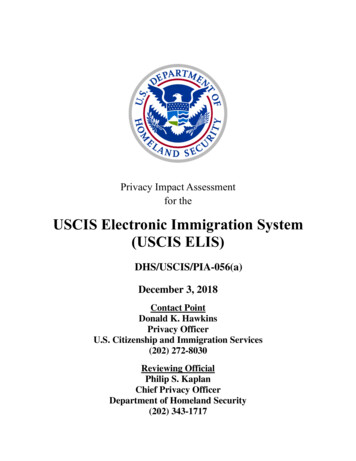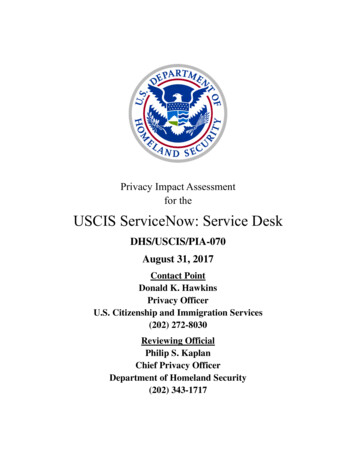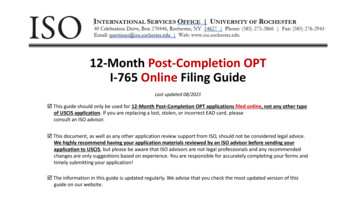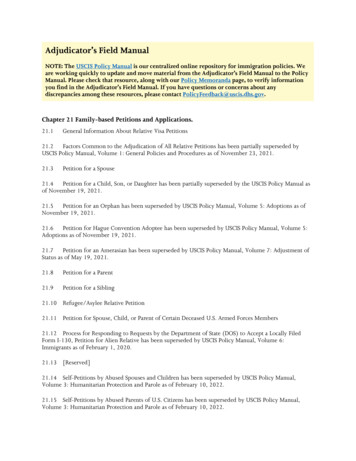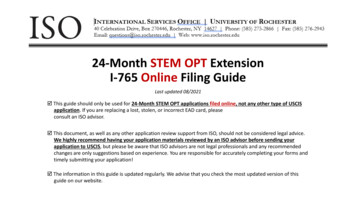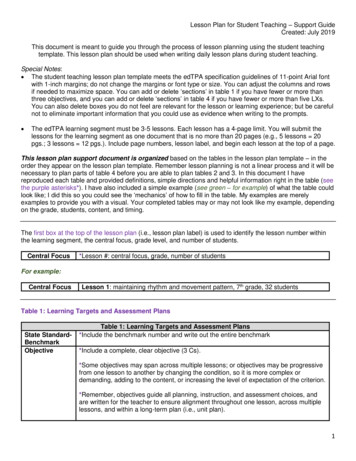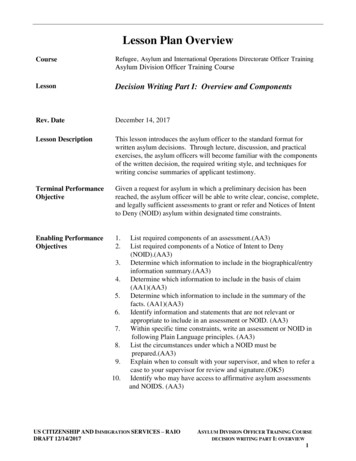
Transcription
Lesson Plan OverviewCourseRefugee, Asylum and International Operations Directorate Officer TrainingLessonDecision Writing Part I: Overview and ComponentsRev. DateDecember 14, 2017Lesson DescriptionThis lesson introduces the asylum officer to the standard format forwritten asylum decisions. Through lecture, discussion, and practicalexercises, the asylum officers will become familiar with the componentsof the written decision, the required writing style, and techniques forwriting concise summaries of applicant testimony.Terminal PerformanceObjectiveGiven a request for asylum in which a preliminary decision has beenreached, the asylum officer will be able to write clear, concise, complete,and legally sufficient assessments to grant or refer and Notices of Intentto Deny (NOID) asylum within designated time constraints.Enabling PerformanceObjectives1.2.Asylum Division Officer Training Course3.4.5.6.7.8.9.10.List required components of an assessment.(AA3)List required components of a Notice of Intent to Deny(NOID).(AA3)Determine which information to include in the biographical/entryinformation summary.(AA3)Determine which information to include in the basis of claim(AA1)(AA3)Determine which information to include in the summary of thefacts. (AA1)(AA3)Identify information and statements that are not relevant orappropriate to include in an assessment or NOID. (AA3)Within specific time constraints, write an assessment or NOID infollowing Plain Language principles. (AA3)List the circumstances under which a NOID must beprepared.(AA3)Explain when to consult with your supervisor, and when to refer acase to your supervisor for review and signature.(OK5)Identify who may have access to affirmative asylum assessmentsand NOIDS. (AA3)US CITIZENSHIP AND IMMIGRATION SERVICES – RAIODRAFT 12/14/2017ASYLUM DIVISION OFFICER TRAINING COURSEDECISION WRITING PART I: OVERVIEW1
Instructional MethodsLecture, Practice ExerciseStudent Materials/ReferencesLesson PlanMethod of EvaluationWritten test, Practical exercise examBackground Reading8 C.F.R. § 208.6US CITIZENSHIP AND IMMIGRATION SERVICES – RAIODRAFT 12/14/2017ASYLUM DIVISION OFFICER TRAINING COURSEDECISION WRITING PART I: OVERVIEW2
NEW CRITICAL TASKSKnowledge of policies and procedures for preparing asylum decision documents. (5)Knowledge of chain of command. (2)Skill in determining materiality of facts, information, and issues. (6)Knowledge of policies and techniques for Plain Language writing. (3)Knowledge of strategies, techniques, and tools for time management. (3)Knowledge of policies and procedures for preparing decision and related documents (e.g., NTA,transportation letters, decision letter). (3 RAIO) (4 ASM)Skill in working independently. (4)Skill in interacting with others in a professional manner (e.g., respectful, courteous). (4)Knowledge of strategies and techniques for note taking. (4)Skill in interacting with others in a professional manner (e.g., respectful, courteous). (4)Knowledge of strategies, techniques, and tools for time management. (3)Skill in using Microsoft Office (e.g., Word, Excel, Outlook, PowerPoint). (3)Skill in taking notes to capture information. (4)US CITIZENSHIP AND IMMIGRATION SERVICES – RAIODRAFT 12/14/2017ASYLUM DIVISION OFFICER TRAINING COURSEDECISION WRITING PART I: OVERVIEW3
TABLE OF CONTENTSI. INTRODUCTION . 5II. OVERVIEW . 5A. Background . 5B. Assessments and NOIDs: Legal Documents to which a Number of Persons Have Access . 5C. Supervisor’s Role . 7III. THE DIFFERENCE BETWEEN AN ASSESSMENT AND A NOID . 7A. Assessment . 7B. NOID. 8IV. COMPONENTS OF AN ASSESSMENT AND A NOID . 9A. Biographic/Entry or Arrival/Immigration Status Information . 9B. Basis of Claim . 10C. Analysis of Prohibitions Against Filing for Asylum. 11D. Summary of Testimony . 12E. Analysis of Credibility /Evidence Assessment . 13F. Focused Legal Analysis . 13G. Analysis of Bars/Discretionary Factors. 13H. Decision . 13V. WRITING STYLE . 14A. Informational Tone . 14B. Language that Is Easy to Understand . 14C. Language Structure, Grammar, and Spelling . 14VI. SUMMARY . 15US CITIZENSHIP AND IMMIGRATION SERVICES – RAIODRAFT 12/14/2017ASYLUM DIVISION OFFICER TRAINING COURSEDECISION WRITING PART I: OVERVIEW4
PresentationI.ReferencesINTRODUCTIONThe purpose of this lesson is to instruct officers how to writeassessments and Notices of Intent to Deny (NOIDs), focusing onthree of the necessary components of these documents: thebiographical/entry information, the basis of the claim, and thesummary of testimony. This lesson will also cover the differencesbetween assessments and Notices of Intent to Deny, and discussappropriate language to use in both documents.II.OVERVIEWA. BackgroundAssessments and Notices of Intent to Deny are legaldocuments that explain the basis for asylum officers' decisions.Prior to “Reform” asylum officers were required to writelengthy decisions, citing all relevant case law and countryconditions information. The writing of assessments andNOIDs, however, has evolved into the streamlined version thatasylum officers now use. One of the purposes of using a morestreamlined written assessment is to reduce the length ofwriting time, which in turn allows more time for interview andcase analysis.Standardized "template" documents for assessments andNOIDs are installed on the Asylum Division computernetwork so that asylum officers can quickly and easily accessand use these documents. Asylum officers should check withtheir local office management for guidance on how to accessthese templates. The use of standardized templates promotesconsistency of work product across the Asylum program.See Asylum Division lessonHistory of the AffirmativeAsylum Program concerning“Reform”Refer to Affirmative AsylumProcedures Manual forcopies of templates.B. Assessments and NOIDs: Legal Documents to which aNumber of Persons Have AccessInformation pertaining to an applicant’s application forasylum—including the assessment or NOID—is generallyprotected from disclosure pursuant to the asylumconfidentiality regulations found at 8 CFR § 208.6. Some ofthe individuals who have access to assessments and NOIDsUS CITIZENSHIP AND IMMIGRATION SERVICES – RAIODRAFT 12/14/2017ASYLUM DIVISION OFFICER TRAINING COURSEDECISION WRITING PART I: OVERVIEW5
include the following:1.The applicant and his or her attorney or legalrepresentative are sent copies of the NOID. Under somecircumstances the assessment may be released to theapplicant or his or her attorney/legal representative if aFreedom of Information Act (FOIA) request is submittedto obtain a copy of an assessment (and other information inthe file).2.Certain Asylum Office staff review assessments andNOIDs.Supervisory asylum officers routinely review allassessments and NOIDs. Certain other Asylum Officestaff, such as the Training Officer(s), Deputy Director,and Director, may also review assessments and NOIDs.In addition, other asylum officers may review files ofcases in which the interviewing officer could notcomplete the case or, in certain instances, if there is aneed to reinterview the applicant.3.The Headquarters Asylum Division Training and QualityAssurance Branch staff reviews assessments and NOIDsfrom certain categories of cases where HQ review isrequired or requested.See Affirmative AsylumProcedures Manual4.ICE Assistant Chief Counsels read certain assessmentsand NOIDs. (In some cases, the Assistant Chief Counselmay enter an assessment or NOID into the record, whichmeans that the immigration judge and others would alsoreview these documents.)Note that asylum officersmay be required to testify inimmigration court as to thecontent of interviews and/ortheir reasoning for reachingparticular decisions.5.The Board of Immigration Appeals (BIA) and federalcourts review certain assessments and NOIDs.6.The Bureau of Democracy, Human Rights, and Labor(DRL) of the Department of State gives advisory opinionson certain claims.7.Certain government officials (e.g., FBI or other lawenforcement agencies) or contractors as indicated in 8C.F.R. §208.6(c) may have access to particular files.8.Members of Congress who receive inquiries fromapplicants may have access to the assessments and NOIDsin the applicants’ files. The Congressional liaisons whoare responsible for responding to Congressional requestsUS CITIZENSHIP AND IMMIGRATION SERVICES – RAIODRAFT 12/14/2017(c)Note that the provisions ofThe Privacy Act of 1974 (5U.S.C. § 552a) wouldrequire that Members ofCongress or their staff obtainASYLUM DIVISION OFFICER TRAINING COURSEDECISION WRITING PART I: OVERVIEW6
also may read certain assessments and NOIDs.written authorization beforethey can acquire informationabout an individual's case.C. Supervisor’s RoleEvery asylum officer is assigned to a supervisory asylumofficer. The supervisory asylum officer is availablethroughout the decision-making process for consultation,guidance, and discussion about the merits of the applicant’sclaim. The supervisor can often direct the asylum officer tolegal and country conditions resources that may be helpful inmaking the decision.See Affirmative AsylumProcedures ManualWhen the asylum officer completes a case, he or she submits itto the supervisor for review and signature. At the time ofsubmission, the file should be in record order and all requireddocuments should be complete and accurate. If no errors arefound, the supervisor signs the necessary documents andforwards the file to the support staff for the next step inprocessing. If any errors are found during the supervisor’sreview, the case is returned to the asylum officer for revision.If the supervisor disagrees with the asylum officer’s analysis,the supervisor discusses the issues with the asylum officer.III. THE DIFFERENCE BETWEEN AN ASSESSMENT AND ANOIDThe basic components of the assessment and NOID are generallythe same. There are a few differences, however, between the twodocuments.A. AssessmentThe assessment is:1.A written document stating the reasons for granting acase, or for referring a case to the Immigration Judge if theapplicant is not in lawful status.2.If the applicant is a class member of the ABC SettlementAgreement (or is a member of the Mendez SettlementAgreement, if in the Los Angeles District), only written if thecase is granted.3.An internal USCIS document that remains in the file. (Seesection II.B above for some exceptions as to when theUS CITIZENSHIP AND IMMIGRATION SERVICES – RAIODRAFT 12/14/2017See ABC/NACARAProcedures Manual forguidanceASYLUM DIVISION OFFICER TRAINING COURSEDECISION WRITING PART I: OVERVIEW7
document may be seen by individuals outside of USCIS.)4.A document containing limited biographic information, asummary of the material facts of the claim, acredibility/evidence assessment, a legal analysis addressingeligibility issues, and a decision (granting asylum or referringthe case to the Immigration Judge). Citations to countryconditions are included only when determinative to thedecision; citations to statutes and case law are used only incertain circumstances. An assessment does not containinformation about the asylum process.5.Not rebuttable by the applicant if the assessment is torefer the case to the Immigration Judge.6.Written in the third person (referencing "the applicant").B. NOIDThe NOID is:1.A preliminary denial of a case.2.Written for cases in which the applicant is in lawfulimmigrant status or is a class member of the ABC SettlementAgreement (in the Los Angeles District, class members ofthe Mendez Settlement Agreement also receive a NOID ifnot granted asylum).3.A document that is sent to the applicant and theapplicant’s representative, if any.4.A document containing limited biographic information, asummary of the material facts of the claim, acredibility/evidence assessment, a legal analysis addressingeligibility issues, and a decision stating that it is the intent ofUSCIS to deny asylum (and in some cases, withholding ofremoval). It also contains limited information about theasylum process, including information about comments fromthe DRL (if relevant and able to be disclosed), the applicant'snext step in the process, and time deadlines.5.A document that includes citations to statute and, in somecases, citations to case law. Citations to country conditionsare included only when determinative to the decision.6.The applicant has the right to rebut the grounds for denialbefore a final decision is rendered by the asylum officer. TheUS CITIZENSHIP AND IMMIGRATION SERVICES – RAIODRAFT 12/14/2017ASYLUM DIVISION OFFICER TRAINING COURSEDECISION WRITING PART I: OVERVIEW8
NOID must specifically address all reasons the applicantwould not establish eligibility for asylum.7.Written in the second person (referencing "you").IV. COMPONENTS OF AN ASSESSMENT AND A NOIDThe contents of assessments and NOIDs can be divided into thefollowing basic components:i.Biographic/Entry or Arrival/Immigration StatusInformationii.Basis of Claimiii.Analysis of Prohibitions Against Filing for Asylumiv.Summary of Testimonyv.Analysis of Credibility/Evidence Assessmentvi.Focused Legal Analysisvii.Analysis of Bars/Discretionary Factorsviii.DecisionThe above-listed components are expanded upon below.A. Biographic/Entry or Arrival/Immigration Status Information1.Includes:a.Age of applicantb.Applicant’s genderc.Country of which applicant is a native and countryor countries of applicant’s citizenship (or, whetherapplicant is stateless)d.Date and place of entry into the United Statese.Manner of entryf.Limited information concerning applicant’simmigration statusUS CITIZENSHIP AND IMMIGRATION SERVICES – RAIODRAFT 12/14/2017ASYLUM DIVISION OFFICER TRAINING COURSEDECISION WRITING PART I: OVERVIEW9
2. Does not include extraneous information such as:a. The applicant's journey to the U.S. (e.g., the route,the length of time, the cost, whether smugglerswere involved);b. How many family members remain in applicant’scountry; orc. Information addressed in other components ofassessment.3. Examples:a. Applicant is a 19-year old male, native and citizenof the People’s Republic of China who entered theU.S. on March 24, 2012. without inspectionsomewhere along the border between Mexico andCalifornia The applicant is not in lawful status.b. Applicant is a 35-year old female, native andcitizen of Ethiopia who was admitted to the U.S.at New York, NY on March 24, 2012 as a F1student for duration of status. The applicant is inlawful status.B. Basis of Claim1. Brief statement of:a. What the applicant fearsb. Whom the applicant fearsc. Country where the harm is fearedd. The protected ground(s), if any, the fear isconnected to (on account of)2. The Basis of Claim component always states the harmthat the applicant fears in the future. It does not includethe legal analysis of eligibility issues, credibility analysisor address past harm the applicant has experienced.Because applicants are not necessarily familiar with U.S.immigration laws and regulations to establish eligibilityfor asylum, the asylum officer must consider thetestimony and other evidence in order to accurately frameUS CITIZENSHIP AND IMMIGRATION SERVICES – RAIODRAFT 12/14/2017ASYLUM DIVISION OFFICER TRAINING COURSEDECISION WRITING PART I: OVERVIEW10
the basis of claim in this component of the writtendecision. This is often the case when the applicant’sclaim in based on his/her membership in a particularsocial group, but may occur in other instances as well.3. Examples:a. An applicant from China claims the policeauthorities detained and beat him because he andhis friends were practicing Falun Gong exercises.The applicant states that Falun Gong is not areligion. Falun Gong is considered an “evil cult”by the Chinese authorities and the InternationalReligion Freedom report includes Falun Gong as areligion. Depending on what information iselicited during the interview, the Basis of Claimcomponent could read as follows:Applicant fears he will be harmed by thegovernment of China on account of his religion orApplicant fears he will be harmed by thegovernment of China on account of his imputedpolitical opinion.b. An applicant from Uzbekistan states that theauthorities will harm him because of his Russianethnic background. During the interview, theofficer elicits information that indicates that theauthorities would be motivated to harm theapplicant because his activities are viewed as apolitical opinion rather than because of his ethnicbackground. The Basis of Claim componentmight read as follows:The applicant fears he will be harmed by theauthorities in Uzbekistan on account of hisnationality and his imputed political opinion.C. Analysis of Prohibitions Against Filing for AsylumThis component addresses whether the applicant is eligible to filefor asylum. For applicants who filed on or after April 1, 1997, anassessment or NOID must address whether the applicant waseligible to apply for asylum.US CITIZENSHIP AND IMMIGRATION SERVICES – RAIODRAFT 12/14/2017This component is discussedin the Asylum Divisionlesson, Decision WritingPart II: Legal AnalysisASYLUM DIVISION OFFICER TRAINING COURSEDECISION WRITING PART I: OVERVIEW11
D. Summary of TestimonyThe summary of testimony is a summary of the material facts ofthe applicant's claim. These are material facts that were elicitedfrom the applicant during the asylum interview.Material facts are those facts that have a direct and substantivebearing on the claim, and which, when analyzed by applying thelaw, determine the outcome of the claim.Generally speaking, material facts are related to the event(s) thatcaused the applicant to leave his or her country and/or theevent(s) that form the basis of the applicant's fear of return.All material facts necessary to construct the legal analysis shouldbe described in the testimony component of the assessment andNOID. Material facts not stated in the summary of testimonyshould not be introduced in the content of the legal analysis.Example:Applicant testified that he became interested in Christianitythrough Christian friends in 2010. In early 2011 he beganattending weekly religious services that were held at a neighbor’shouse. In December 2011 he offered to host the Christmas serviceat his house because his neighbor was ill. During the service thepolice came to his home, and took the applicant to the localstation. The police also confiscated the religious materials thatwere at his home. The applicant was detained for three days,during which time he was advised his religious activities were notpermitted and was questioned as to the content and how heobtained the confiscated materials. The authorities also wanted tohim to provide information on his contact with foreignmissionaries. When he denied knowing any foreigners, he wasstruck repeatedly with a baton. The applicant was warned not toparticipate in any further unauthorized house church activitiesand required to report to the station on a weekly basis for 3months. He fears that he will be arrested and further harmed bythe authorities if he returns to China.US CITIZENSHIP AND IMMIGRATION SERVICES – RAIODRAFT 12/14/2017ASYLUM DIVISION OFFICER TRAINING COURSEDECISION WRITING PART I: OVERVIEW12
E. Analysis of Credibility/Evidence AssessmentThe asylum officer must make a determination as to theapplicant's credibility in every assessment of asylum eligibility.The credibility determination is made after the summary of facts.If a negative credibility determination is made, the asylum officermust explain in the assessment or NOID the reasons for findingthe applicant not credible.See Asylum Division lesson,Decision Writing Part II:Legal Analysis for discussionof the credibility andevidence assessment.A negative credibility determination always requires anassessment of other available evidence before it can bedetermined that the applicant did not meet his/her burden ofproof.F. Focused Legal AnalysisThe asylum officer's legal rationale for the decision must beincluded in every assessment and NOID. Note that while the“Focused Legal Analysis” component addresses eligibility issuessuch as past persecution, well-founded fear of future persecution;several other “components” of a written assessment or NOID maycontain legal analysis.Legal analysis is discussed indepth in Asylum Divisionlesson, Decision WritingPart II: Legal Analysis.G. Analysis of Bars/Discretionary FactorsThe “Analysis of Bars/Discretionary Factors” componentaddresses whether an applicant who has established refugeeeligibility is eligible for a grant of asylum. Although thiscomponent must be present in all assessments to grant, certaintypes of decisions do not require that this component be included.Analysis ofBars/Discretionary Factorsis discussed in depth inAsylum Division lesson,Decision Writing Part II:Legal AnalysisH. DecisionThis is the outcome of the asylum officer's legal analysis of theapplicant's request for asylum. In an assessment, the Decisionstates whether the case is granted or referred. In a NOID, theDecision indicates that USCIS finds that the applicant is noteligible for asylum (and in some cases, withholding of removal)and intends to deny the request. There must be a Decision inevery assessment or NOID.US CITIZENSHIP AND IMMIGRATION SERVICES – RAIODRAFT 12/14/2017ASYLUM DIVISION OFFICER TRAINING COURSEDECISION WRITING PART I: OVERVIEW13
V. WRITING STYLEAssessments and NOIDs should be informational in tone andwritten in language that the reader can easily understand.A. Informational Tone1. The assessment is written in the third person, referencing"the applicant"; the NOID is written in the second person,referencing "you."2. There should not be any reference to the first personpronoun "I" in either of these documents. The asylumofficer is representing USCIS when writing thesedocuments and so the term "USCIS" is used rather than"the asylum officer" or "I." For example, "United StatesCitizenship and Immigration Services (USCIS) findsthat." is used instead of "The asylum officer finds that."or "I find that."3. The asylum officer should not include his or her personalopinions, or value judgments, either positive or negative,when writing these documents. Both assessments andNOIDs should be strictly informational in tone.B. Language that Is Easy to UnderstandAssessments and NOIDs should be written in language that thereader can easily understand, avoiding excessive legalterminology and superfluous language. Whenever possible, usethe active voice, short paragraphs and sentences, and simplewords and pronouns. While these are sound principles of writinggenerally, these principles were incorporated into U.S. lawthrough the Plain Writing Act of 2010.See RAIO Module: DecisionMaking for more detaileddiscussion.C. Language Structure, Grammar, and SpellingAlthough officers are under time constraints and need to writemultiple assessments every week, the asylum officer shouldquickly review his or her assessments and NOIDs for grammarand spelling before giving them to a supervisor for review.Computer word processing software is equipped with a "spellcheck" function that should always be used on final versions ofthese documents. Officers should verify that the autocorrectfeature has not inadvertently altered the meaning of any words orphrases. "Grammar check” can also be helpful.US CITIZENSHIP AND IMMIGRATION SERVICES – RAIODRAFT 12/14/2017ASYLUM DIVISION OFFICER TRAINING COURSEDECISION WRITING PART I: OVERVIEW14
VI. SUMMARYA.Assessments and Notices of Intent to Deny (NOIDs) are legaldocuments that explain the bases for asylum officers' decisionsin asylum cases.B.A number of persons may have access to assessments andNOIDs including, but not limited to:C.1.The applicant and his or her attorney or legalrepresentative;2.Asylum Office staff;3.Headquarters staff;4.ICE Assistant Chief Counsels;5.The BIA and federal courts;6.Staff from the Bureau of Democracy, Human Rights, andLabor (DRL) of the Department of State; and7.Certain government officials as indicated in 8 C.F.R. §208.6(c).8 C.F.R. § 208.6(c)There are several differences between assessments and NOIDs1. An assessment is an internal USCIS document written forall grants and for referrals of cases in which the asylumapplicant is not in status. If the asylum applicant is anABC class member (or a class member of the MendezSettlement Agreement), an assessment is only written ifthe case is granted. Written in the third person,referencing "the applicant," it explains the reasons forgranting a case or referring a case to an immigrationjudge. It includes limited legal and country conditionsinformation and does not include information about theasylum process. If the case is referred, the applicant is notgiven an opportunity to rebut the reasons the applicantwas not found eligible.2. A Notice of Intent to Deny (NOID) is a preliminary denialletter written for cases in which the applicant is in statusor is an ABC class member (or a class member of theMendez Settlement Agreement). It is written in thesecond person, referencing "you," and is sent to theUS CITIZENSHIP AND IMMIGRATION SERVICES – RAIODRAFT 12/14/2017ASYLUM DIVISION OFFICER TRAINING COURSEDECISION WRITING PART I: OVERVIEW15
applicant and representative, if any. In addition to legaland country conditions information, it contains limitedinformation about the asylum process, and gives theapplicant an opportunity to rebut all the grounds for denialbefore a final decision is rendered.D.Although there are several differences between assessmentsand NOIDs, they contain the same basic components, whichare:i. Biographic/Entry or Arrival/Immigration StatusInformationii. Basis of Claimiii. Analysis of Prohibitions Against Filing forAsylumiv. Summary of Testimonyv. Analysis of Credibility /Evidence Assessmentvi. Focused Legal analysisvii. Analysis of Bars/Discretionary Factorsviii. DecisionE.Assessments and NOIDs should be informational in tone andshould be written in language that is easily understood,without any reference to the first person pronoun "I" or "theasylum officer." They should not include any personalopinions of the asylum officer.US CITIZENSHIP AND IMMIGRATION SERVICES – RAIODRAFT 12/14/2017ASYLUM DIVISION OFFICER TRAINING COURSEDECISION WRITING PART I: OVERVIEW16
Lesson Description This lesson introduces the asylum officer to the standard format for written asylum decisions. Through lecture, discussion, and practical exercises, the asylum officers will become familiar with the components of the written decision, the required writing style, and techniques for writing concise summaries of applicant testimony.

